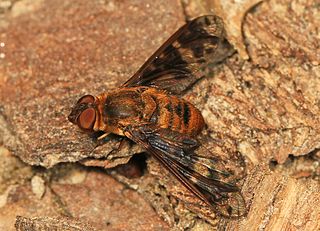
The Bombyliidae are a family of flies, commonly known as bee flies. Some are colloquially known as bomber flies. Adults generally feed on nectar and pollen, some being important pollinators. Larvae are mostly parasitoids of other insects.

Toxophora is a genus of flies belonging to the family Bombyliidae (bee-flies). There are about 47 described species, distributed throughout the world, although they are most abundant in Southwestern United States and western Mediterranean. They are stout, robust flies with a hunchbacked form, with a body length of 6–12 mm and wings 4 to 7.5mm. Most species are black with banding or spots.

Toxophorinae is a subfamily of bee flies in the family Bombyliidae. There are five living genera and two extinct genera containing more than 400 described species in Toxophorinae.

Systoechus is a genus of bee flies in the family Bombyliidae. There are more than 120 described species in Systoechus.
Conophorus obesulus is a species of bee fly in the family Bombyliidae. It is found in the western United States from California to Colorado, and north to British Columbia, Canada.
Thyridanthrax selene is a species of bee fly in the family Bombyliidae. It is known from the southwestern United States and northwestern Mexico.

Systoechus solitus is a species of bee fly in the family Bombyliidae. It is found in the southeastern United States from New Jersey to Florida and Louisiana. Its larvae are predators of grasshopper eggs.
Lordotus junceus is a species of bee fly in the family Bombyliidae.
Diochanthrax is a genus of bee flies in the family Bombyliidae. There is one described species in Diochanthrax, D. morulus, found in California.
Lordotus zona is a species of bee fly in the family Bombyliidae.
Chrysanthrax lepidotoides is a species of bee fly in the family Bombyliidae. It is known only from New Jersey.
Toxophora pellucida is a species of bee fly in the family Bombyliidae. It is found from Mexico through most of the western United States north to Canada.
Conophorus fenestratus is a species of bee fly in the family Bombyliidae. It is found in the western United States from Washington to Arizona and in Baja California Sur, Mexico.

Chrysanthrax edititius is a species of bee fly in the family Bombyliidae. It is widespread in the United States from Oregon to Michigan, south through Mexico to Guatemala and Honduras.

Dipalta banksi, the Huron shore bee fly, is a species of bee fly in the family Bombyliidae.
Toxophora leucopyga is a species of bee fly in the family Bombyliidae. It is found in the southwestern United States from Louisiana to North Carolina

Thyridanthrax fenestratoides is a species of bee fly in the family Bombyliidae. It is found in Canada from the Yukon to Ontario, south through most of the United States, and into Mexico. It is similar to the species T. fenestratus from Eurasia.
Toxophora maxima is a species of bee fly in the family Bombyliidae. It is found from Mexico through most of the western United States north to British Columbia, Canada.
Conophorus fallax is a species of bee fly in the family Bombyliidae. It is found in North America, from the Yukon to Saskatchewan in Canada south to New Mexico and California in the United States.

Toxophora amphitea is a species of bee fly in the family Bombyliidae. It is found in eastern North America from Ontario south to Florida and Texas.







